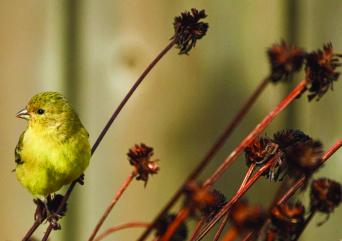
Gardening for the Birds
Birds are great visitors to any garden. The greater the diversity of plants, the more successful you will be in attracting a variety of birds. Include as many native plants as possible as they have evolved along with the birds, providing food and shelter in a timely fashion.
The closer you can come to creating a native landscape, the more birds will be attracted.
Include evergreens around your property borders to provide cover and nesting areas, especially berry producers for winter food.
Hollies (Ilex species) are among the most valuable and versatile resources for birds, serving as shelter sites and nesting areas in their densely covered branches. Hundreds of fruiting varieties come in a variety of colors — red, yellow, orange, white and black. The fruit is enjoyed by robins, cardinals, waxwings, jays, woodpeckers, chickadees and others.
Roses, mahonia and other thorny shrubs create good protection. Serviceberries (Amelanchier) and chokeberries (Aronia), after flowering, provide berries in a variety of sizes and colors. Beautyberry (Callicarpa americana) provides purple or white berries in fall through winter, attracting cardinals, mockingbirds, thrushes, woodpeckers and sparrows. Viburnum, blueberries, crabapples and hawthorn (Crataegus) feed cedar waxwings and cardinals during winter months.
Seed-forming perennial flowers are appreciated by a variety of birds. Hold off cutting back faded blooms of coneflower (Echinacea purpurea). The goldfinches love the seeds. The seedheads on many ornamental grasses are also appreciated. Sedum species develop seedheads from late autumn to winter, attracting many birds, especially finches and chickadees.
When cleaning up yard waste, stash some piles of debris under shrubs and trees. That will attract pillbugs, worms and other insects that ground-feeding birds such as brown thrashers will be attracted to.
Bird diets usually change throughout the season. During spring and summer, many songbirds prefer insects as their primary food source. Later, during migration, birds are looking for seeds and berries. In our area, insects are not available in winter, so our residents are likely to be chickadees and cardinals and the like that need the seeds and berries.
Hummingbirds are attracted to numerous flowering plants, especially Agastache species like giant blue hyssop. These can be planted throughout your borders and beds and require no fertilizer or watering (other than in extreme drought). There are many varieties in all sizes and colors. I have them growing around my deck, and the hummingbirds are at the spiked blossoms all summer long. Other hummingbird attractors include Salvia (sage), Kniphofia (torch lily), Penstemon (beardtongue) and Achillea (yarrow).
None of us wants insects eating our veggies but please, refrain from the use of pesticides. Not only will you deplete the food source for phoebes, nuthatches and warblers, but you will poison the birds that eat any insects that contain the insecticide.
Make sure you have a water source like a bird bath. Birds need water all of the time, even during winter months. Shallow is better, about 2 inches deep. If you keep the water moving, it tends to attract more birds. A device such as a battery-operated “Water Wiggler” does the trick. There are heaters available for winter use to prevent freezing.
For more detailed information about the birds in your garden, go to www.allaboutbirds.org. This is the official website for the Cornell Lab of Ornithology
Questions or comments: ron@primexgardencenter.com.

